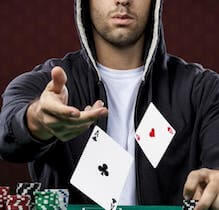Basic Poker Strategy for New Players

Poker is a fun and easy game to grasp, but mastering to become a winner among tons of players looking to make thousands of dollars, is tricky and damn hard. The place to begin winning some money is online poker, where you will find rookies like yourself and most of them are not taking the time or effort to read basic poker strategy. This gives you an edge over them.
Win All the Time, or Play Your Best Hand Always?
This will define your level of professionalism. Decide from the start you will be playing the best poker hand, always. That means folding when you need to, and raising when it is the most logical thing to do. Stop thinking you need to win every hand, instead exploit those guys.
Know that you know very little. So you will make mistakes, constantly. Record yourself playing online to analyze what you should have done differently. Remember these scenarios on your next playing sessions to make the correct decisions on a live game.
Basic Poker Math
This is a game of odds. Who has the biggest odds to win the hand? How can I improve those odds? Two problems you should be solving on every hand. Keep the odds in your favor and you will reach the final table more often than not.
Starting Hands
Your starting hand is the most important one. Master starting hands guidelines to gain an edge, you can master a starting hand chart from this poker charts resource (number 7).
Decisions at the End of Each Hand
This is more advanced. Most players can learn how to begin a round, but fail to have a plan to continue the following hands and subsequent action. You need to learn to calculate pot odds, recognize betting patterns, bluffing, and using position. Learning this takes time and experience, lots of play. A small improvement in this area can make a huge difference.
No Emotional Breakdowns
Poker can get very emotional and you might end up betraying all your learning in one single crazy hand. Do not get carried away from the pot size, your chip size, a big win or loss. Keep your cool and follow the strategy steps to the end.
Player Style
There are 4 different player styles to play poker. You will be one of them. The best poker players can shift their style to counter or defend themselves from opponents.
Tight: Plays few hands and is very cautious. Doesn´t take too many risks.
Loose: Plays a lot of hands and is willing to gamble.
Aggressive: Bets hard with many raises and goes after big pots.
Passive: The call raises but do not lead them. They allow aggressive players dictate the flow of the action.
Mastering all of these and knowing when to apply is key to becoming a master of poker. However, new players can stick to a “tight-aggressive” style while integrating the others. This style moderates in how many hands you participate, while going hard when the odds are in your favor. Shift to a more aggressive player as you become more experienced.
Position is Key
The dealer is called the “button”. This is the last player to act in a betting round, and gives the button a tactical advantage by knowing how opponents have acted. The button changes each round so each player gets a chance.
To use this tactical advantage in your favor, play more hands when in late position and even make a raise when the other players looked tight or passive, even if your hand is not the strongest.
Knowing When to Bluff
Bluffing is the art of compelling your opponents to fold when your own hand is worst than theirs. In poker, most dealt hands will be junk. Bluffing becomes a necessity from time to time to win some of those weak hands.
The key to bluffing is to be consistent with your player style from the start of the hand till the end. You cannot begin aggressive, then passive all of a sudden when the flop comes out. If you want to pretend you nailed a huge pair, then act like you did from beginning to end.
Make sure you read opponents correctly. It is easier to bluff against passive and tight players than aggressive ones.
Master Odds
This is probably the biggest poker tip of all. If you are good at making mental calculations of the odds an opponent has an Ace or not, then you can narrow down the best possible decisions to make. There are several poker odds training resources online to master this. After some practice you will get a hold of it.
Pot Odds
This is the math of deciding if it makes sense to risk chips for the prize presently in the pot. Let’s say you are in a situation where the pot size is 20 chips, you need to bet 10 to continue in the game. The pot odds are 2 to 1, but the odds of you getting the card that can help you win are closer to 4 to 1. Taking a 4/1 risk for a 2/1 payout sounds like bad business. Better to fold.
Let’s evaluate this same scenario with a payout of 10 to 1, meaning you are asked to bet 10 chips on a pot that is already 90 chips in size. You still have a 4 to 1 chances of getting the winning card, but now 4/1 to win 10/1 sounds like a risk worth taking.
Explore these basic poker strategy tips against low stake tables and read some beginner poker books. Tournaments are the best place to test. Focus on how you implement each tactic.
After nailing poker you can test other casino games that require similar player skill.